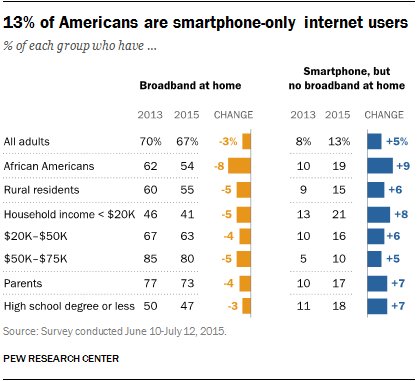New Economic Realities of Home Access
The graph above from the Pew Research Center challenged some of my assumptions about the use of Broadband internet connections at home. I had always assumed that the rise of internet use in education and in our society as a whole would mean that more and more people would end up seeing access as a necessity. In the past few years, though, broadband use at home in many groups is actually declining!
A recent trend has been for families to drop their land lines in favor of just having a cell phone. Dropping the land line saves money and avoids a duplication of services. As a benefit, smart phones are subject to far fewer cold calls and surveys, and that is especially important during election season!
Likewise, it seems that many people who have smartphones and who are on a very limited budget feel that smartphone internet access duplicates a broadband service, so paying for broadband is something that could be avoided.
In education, some internet tasks can be done successfully on a smartphone. However, more creative and collaborative tasks really do need a larger screen and faster connectivity. Additionally, reading documents online and highlighting them and adding comments is very difficult to do effectively on a smart phone. Smart phone connectivity can certainly be helpful in education, but viewing it as a good substitute for high speed broadband connectivity is a mistake. As education evolves and teachers change their practice to take full advantage of teaching, learning, collaborating, and creating, those students who only have cell phone connectivity at home will be at a marked disadvantage.
No comments:
Post a Comment